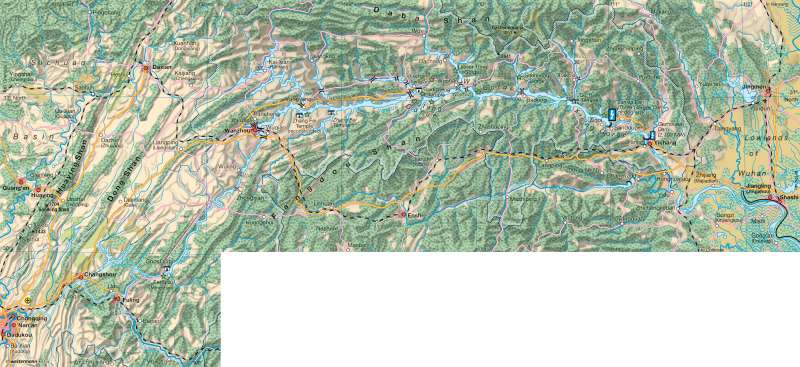Yangtze River — Three Gorges Project
China and Japan
978-3-14-100790-9 | Page 110 | Ill. 2

Information
The Yangtze River, the largest river in China, breaks through the eastern boundary of the Sichuan basin in a 200 kilometre long, deeply cut valley with a largely gorge-like character. The valley's narrowest sections are the "Three Gorges" (Qutang, Wu and Xiling). The dam is located halfway along the Xiling Gorge, some 40 kilometres before the Yangtze River leaves the mountains near Yichang. In 2003, work started on raising the water level, which was planned to reach 175 metres above sea level in 2009. The dam wall is 2,310 metres long and 185 metres high. The reservoir is 660 kilometres long and an average of 1.1 kilometres wide (i.e. double its width before damming). The functional units and further dimensions are illustrated in the sketch that accompanies the map.The controversial project pursues three main objectives:
— Energy generation in hydroelectric power stations (18,000 MW),
— Flood protection and regulation of the rate of flow for half of the river's total annual discharge (at Yichang 480 billion m³, at the mouth 960 billion m³),
— Improvements in navigability.
As a precursor of the Three Gorges Dam, the substantially smaller Gezhouba Dam was constructed in the 1950s and 1960s (40 kilometres downriver, see map). At that time there were already preliminary ideas for a Three Gorges Dam, but these were not taken up again and pursued until 1985. Construction, which is estimated to have cost up to 75 billion US dollars, began in 1994.
Damming and its Consequences
The filling of the reservoir will be completed in 2009. This will only result in a limited widening of the lake area in the steeply-sloped gorges, while above the gorges the increase in width will also be limited when reservoir water levels are lower.
Ships of up to 10,000 tons can now pass from Shanghai as far as Chongqing, the centre of Sichuan, with significantly reduced freight costs. Side arms such as the "Little Three Gorges" near Wushan have become navigable more easily and for a greater distance, and can be newly opened up to tourism. The Three Gorges Dam was controversial in China from the start, and has also given rise to international protests. The project's opponents believe that there is a not inconsiderable danger of the dam breaching, and they recall the catastrophe in Henan Province in 1975 in which 230,000 people lost their lives when two dams built in the 1950s burst. The financial costs are also the subject of criticism, as is the immense ecological impact and the social effect of relocation. The loss of land and of cultural sites (temples; see map) can also be seen in a negative light.
Despite their similar appearance due to the yellow colouring of the water, the sediment load is substantially lower than in the Yellow River (water-borne sediment concentration of 1.2 kg/m³ against 37 kg/m³). The "flow characteristics" of the reservoir are relatively favourable because of its narrow width and the high volume of water carried. With the reduced speed of flow, much of the water-borne sediment is already deposited in the upper reaches of the reservoir. In addition, outlets for sediment-bearing water have been built low down into the dam wall. Deposits of 8 to 9 million tons of silt per year in the reservoir are anticipated. The inflow of waste water into the reservoir is currently stated to be around 1.2 billion tons per year. There are plans to build waste water treatment plants, but no reliable data is available on plants that have been completed and put into operation. Water quality is very important for the planned south-north water transfer.
Beyond its direct consequences, the construction of the dam has proved to be a key project in the ongoing complete opening up of the Sichuan region. Before the dam was built there was not a single bridge between Chongqing and the dam site, but in 2006 there were already more than 20. Others are under construction, including the enormously tall railway bridge near Wanzhou, over which Sichuan will gain a direct rail link to the east for the first time. In addition there are new roads, motorways and residential buildings.
W. Hassenpflug; Ü: J. Attfield




